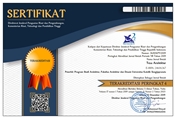POLA TERITORIALITAS DAN PERSONALISASI RUANG DI ASRAMA – BOARDING SCHOOL SEMI MILITER (Territoriality Patterns and Personalization of Space In a Semi-Military Boarding Schools Environment)
Abstract
Penelitian ini membahas pola teritorialitas dan personalisasi ruang di asrama Boarding School semi militer, dengan fokus pada perilaku spasial siswa terhadap pengaturan dan penggunaan ruang di asrama. Teritorialitas dalam penelitian ini mengacu pada klaim ruang yang dilakukan oleh siswa untuk menunjukkan identitas diri, dan menciptakan rasa aman dalam lingkungan yang terstruktur serta memiliki tingkat kedisiplinan yang tinggi. Sementara personalisasi ruang, seperti dekorasi dan pengaturan barang pribadi bertujuan untuk memperkuat rasa kepemilikan dan kebersamaan, mengurangi potensi konflik antar sesama, dan meningkatkan kesejahteraan emosional siswa. Metode yang digunakan dalam penelitian ini adalah tinjauan pustaka (literature review) dengan analisis deskriptif, yang disertai dengan observasi lapangan untuk mendapatkan data empiris sebagai pemahaman lebih lanjut mengenai pola teritorialitas dan personalisasi ruang di lingkungan asrama - Boarding School semi militer. Hasil dari penelitian ini diharapkan dapat memberikan wawasan yang bermanfaat bagi pihak sekolah dan desainer dalam mendesain ruang yang lebih sesuai dengan kebutuhan siswa, sehingga dapat mendorong perkembangan sosial dan emosional mereka.
Keywords
Full Text:
PDF (Bahasa Indonesia)References
Abu-Ghazzeh, T. M. (2000). Environmental messages in multiple-family housing: Territory and personalization. Landscape Research, 25(1), 97–115. https://doi.org/10.1080/014263900113190
Abu-Obeid, N. N., & Ibrahim, A. F. (2002). The effect of dormitory type and room view on the perception of privacy and territoriality by female residents. Architectural Science Review, 45(3), 231–241. https://doi.org/10.1080/00038628.2002.9697514
Altman, I. (1975). The Environment and Social Behavior: Privacy, Personal Space, Territory, Crowding. Brooks/Cole Publishing Company.
Blom, J. (2000). Personalization - A taxonomy. Conference on Human Factors in Computing Systems - Proceedings, April, 313–314. https://doi.org/10.1145/633292.633483
Brower, S. N. (1976) Territory in Urban Settings, in Altman, (1980), Human Behavior and Environment, Plenary Press, NY, and London.
Brower, S. N. (1980). Territory in Urban Settings. Environment and Culture, 179–207. https://doi.org/10.1007/978-1-4899-0451-5_6
Brunia, S., & Hartjes‐Gosselink, A. (2009). Personalization in non‐territorial offices: A study of a human need. Journal of Corporate Real
Estate, 11(3), 169–182. https://doi.org/https://doi.org/10.1108/14630010910985922
Cho, S.-H., & Choi, I.-Y. (2011). Design Elements Related to Territoriality for Apartment Community Design. Journal of the Korean Housing Association, 22(1), 57–64. https://doi.org/10.6107/jkha.2011.22.1.057
de Yong, S., Rachmawati, M., & Defiana, I. (2021). Rethinking territoriality concept on public space after pandemic COVID-19. International Journal of Public Health Science, 10(4), 856–864. https://doi.org/10.11591/IJPHS.V10I4.20825
Dewi Nur’aini, R., & Ikaputra. (2019). Teritorialitas Dalam Tinjauan Ilmu Arsitektur. INERSIA: Iformasi Dan Ekspose Hasil Riset Teknik SIpil Dan Arsitektur, 15(1), 12–22. https://doi.org/10.21831/inersia.v15i1.24860
Edney, J. J. (1976). Human Territories: Comment on Functional Properties. Environment and Behavior, 8(1), 31–47.
Gymnastiar, I. A., Hufad, A., & Wahyuni, S. (2023). The Role of the Boarding School System on Leadership Character Building and 21st Century Skills in High School Students at Global Islamic Boarding School South Kalimantan. Jurnal Penelitian Pendidikan, 23(1), 110–121. https://ejournal.upi.edu/index.php/JER/article/view/56538
Hamriana, H., Kasmawati, K., & Ahmad, A. (2021). Meningkatkan Hasil Belajar Ipa Materi Gaya dan Gerak Melalui Pendekatan Saintifik Dengan Menggunakan Model Problem Based Learning (PBL) di Kelas IV SDN 7 Pasir Putih. Jurnal Sultra Elementary School, 2(2), 83–88. https://doi.org/https://doi.org/10.1234/jses.v2i2.38
Hidayatullah, R., T. Pido, S. A., & Yasin, Z. (2020). Efektivitas Manajemen Boarding School Dalam Peningkatan disiplin Taruna Berbasis Semi Militer SMA Terpadu Wira Bhakti Gorontalo. Tadbir: Jurnal Manajemen Pendidikan Islam, 8(2), 178–187. https://doi.org/10.30603/tjmpi.v8i2.1740
Kaya, N., & Weber, M. J. (2003). Territorial behavior in residence halls: A cross-cultural study. Environment and Behavior, 35(3), 400–414. https://doi.org/10.1177/0013916503035003005
Klinkhammer, D., Nitsche, M., Specht, M., & Reiterer, H. (2011). Adaptive personal territories for co-located tabletop interaction in a museum setting. Proceedings of the ACM International Conference on Interactive Tabletops and Surfaces, ITS’11, 107–110. https://doi.org/10.1145/2076354.2076375
Lang, J. (1987). Creating Architectural Theory: The Role of the Behavioral Sciences in Environmental Design. In Van Nostrand Reinhold Company.
Ma’rufa, I. (2020). Mekanisme Privasi Spasial Pada Perumahan Komunal Di Surabaya.
Maksudin. (2008). Pendidikan Nilai Boarding School di SMPIT Yogyakarta. Yogyakarta: UIN Sunan Kalijaga.
Martin, A. J., Papworth, B., Ginns, P., & Liem, G. A. D. (2014). Boarding School, Academic Motivation and Engagement, and Psychological Well-Being: A Large-Scale Investigation. American Educational Research Journal, 51(5), 1007–1049. https://doi.org/10.3102/0002831214532164
Mercer, G. W., & Benjamin, M. L. (1980). Spatial Behavior of University Undergraduates in Double‐Occupany Residence Rooms: An Inventory of Effects. Journal of Applied Social Psychology, 10(1), 32–44. https://doi.org/10.1111/j.1559-1816.1980.tb00691.x
Nur’aini, R. D., Setiawan, B., & Marcillia, S. R. (2024). Territory of Children’s Female Bedroom at Pesantren Al Hikmah II Yogyakarta, Indonesia. International Journal of Research and Scientific Innovation, XI(I), 154–165. https://doi.org/10.51244/ijrsi.2024.1101013
Shane, E., Maldonado, N. L., Lacey, C. H., & Thompson, S. D. (2008). Military Boarding School perspectives of parental choice: A qualitative inquiry. Journal of School Choice, 2(2), 179–198. https://doi.org/10.1080/15582150802208659
Sommer, R. (1969). Personal Space; Updated, The Behavioral Basis of Design. Prentice-Hall. https://doi.org/10.2307/2093905
Sundstrom, E. (1986). Work Places. The psychology of the physical environment in offices and factories. Cambridge University Press. (Chapter 11: Symbolic Workspace: Self-identity and Status, p. 217-251.)
Taylor, L. R., & Taylor, R. B. (1989). Human Territorial Functioning. In The Journal of Animal Ecology (Vol. 58, Issue 2). https://doi.org/10.2307/4866
Van der Voordt, D. J. M., & Meel, J. J. van. (2002). Psychologische aspecten van kantoorinnovatie. Faculteit Bouwkunde, Technische Universiteit Delft.
Zhong, Z., Feng, Y., & Xu, Y. (2024). The impact of Boarding School on student development in primary and secondary schools: a meta-analysis. Frontiers in Psychology, 15(March), 1–12. https://doi.org/10.3389/fpsyg.2024.1359626
Zubaidi, F. (2019). Types and patterns of territory in the traditional settlement of Ngata Toro. Architecture&ENVIRONMENT, 18(2), 123–134. https://doi.org/https://doi.org/10.12962/j2355262x.v18i2.a6029
DOI: https://doi.org/10.24167/tesa.v23i1.13062
ISSN 1410-6094 (Print) | ISSN 2460-6367 (Media Online) | View My Stats

This work is licensed under a Creative Commons Attribution 4.0 International License.








